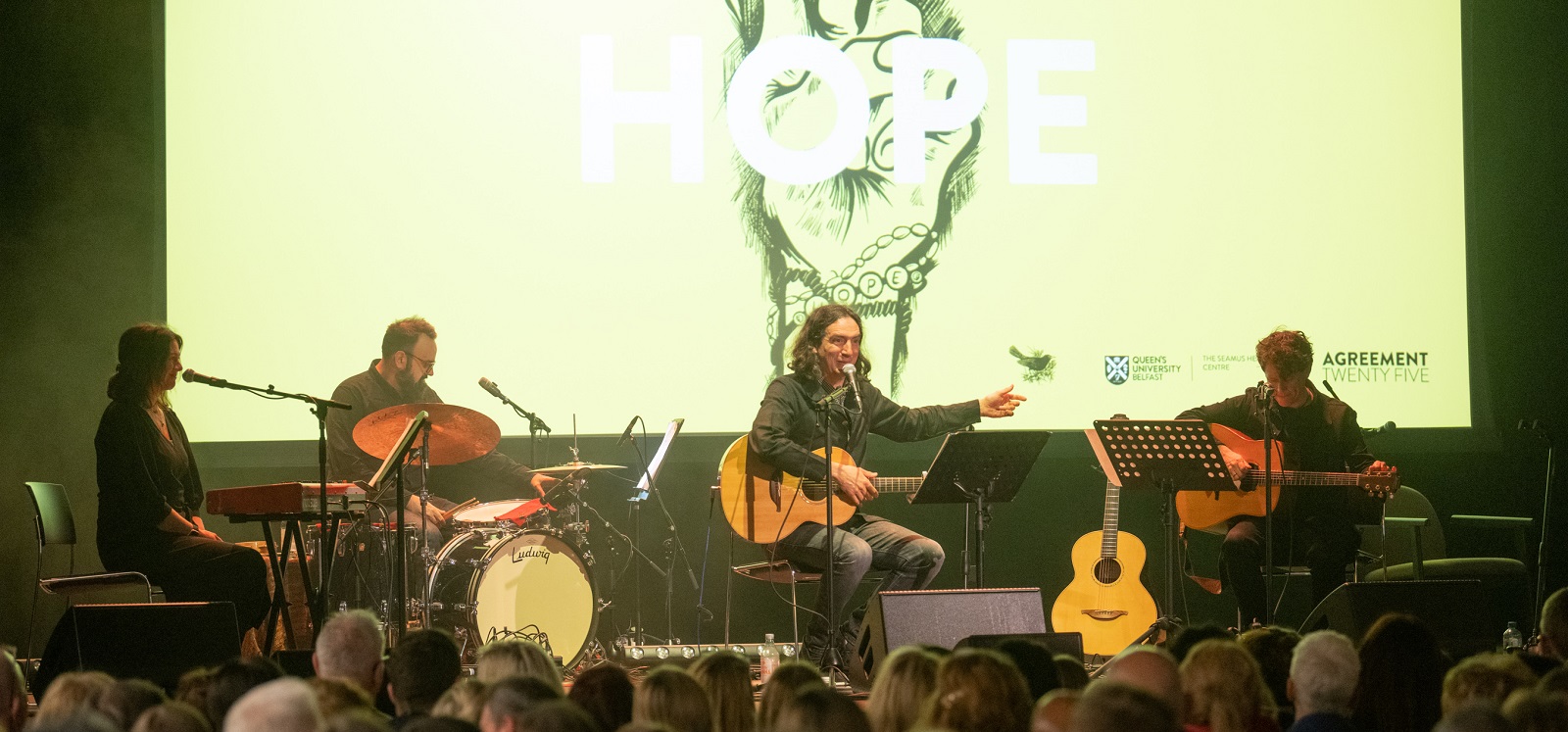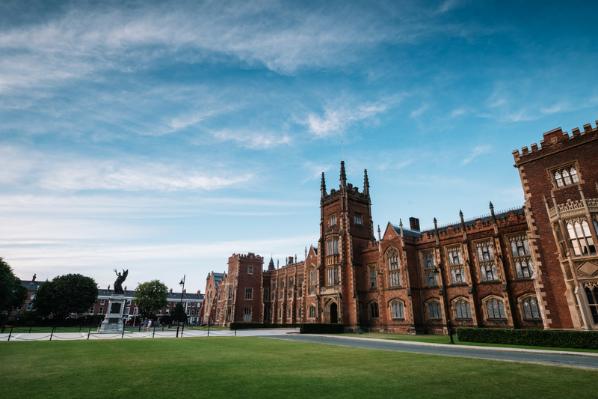BLOG: Agreement 25 – The role of the arts in peacebuilding
"The arts play a significant role in conflict zones for diverting attention from the horrors of war and in redirecting post-conflict strategies towards social rebuilding."

A blog by Professor Fiona Magowan, Senator George J. Mitchell Institute for Global Peace, Security and Justice.
The 25th anniversary of the Good Friday Agreement is an opportune time to reflect upon the role of the arts in peacebuilding, which comprises a research strand in the Religion, Arts and Peacebuilding Theme of the Senator George J. Mitchell Institute at Queen’s.
The arts play a significant role in conflict zones for diverting attention from the horrors of war and in redirecting post-conflict strategies towards social rebuilding by helping to create conditions of trust, empathy, awareness-raising and rigorous engagement with diversity. Artistic practice can be a means of rising above the desolation experienced by the ravages of conflict and a way to articulate the experiences and emotions evoked by such conflicts. As John Paul Lederach has noted, ‘peace-building is an approach that addresses the culture of violence, by transforming it into the culture of dialogue’.[1]
The trauma arising from conflict means that the arts should be used sensitively in ways that support participants as they seek to deal with traumatic effects and the complex interrelationships between forgiveness and remembrance. That also includes the right to forget what has happened as artistic forms can provide arenas for self-expression in the present moment not just as a means of reflecting upon the past. Consequently, methods employed for arts in peacebuilding should be emergent from the needs of the individual or groups involved. This is especially so in looking towards the future of using arts in peacebuilding with young people in Northern Ireland who come from a diversity of socio-cultural backgrounds and conflict/post-conflict experiences.
The work of many arts, theatre, music and dance organisations across the region has brought significant intergenerational insights into how the arts can address identities, effect transformation, work towards reconciling divisive perspectives, help to heal the past and give direction for the future.
This is especially evident in the activities of the Belfast-based arts organisation Beyond Skin run by Darren Ferguson[2] for example, whose artistic remit extends from facilitating new ‘marching metal’ music – a fusion between marching bands and heavy rock music in Northern Ireland – to supporting refugees from Afghanistan and other countries as they seek to practice their musical and artistic repertoires. Such organisations have been working tirelessly to change attitudes through the arts. Taylor (2021: 56) further reports for example, how the ‘deliberate intervention’ of one of Belfast’s first public festivals held in September 1995 organised by David Boyd director of the Beat Carnival was a ‘dizzying, dazzling alternative to sectarian marching’.[3] These organisations appreciate the complex relationship that exists between politics and the arts in which identity processes comprise a contested arena of negotiation. Thus participants need to be able to explore various facets of identity discourse and experience in and through safe spaces that such creative practices can provide.
One example of how these issues have been addressed in the Mitchell Institute is in an AHRC (Arts and Humanities Research Council)/PaCCS (Partnership in Conflict Crime and Security Research) funded project entitled Sounding Conflict: From Resistance to Reconciliation.[4] This project has investigated how both young people’s and adults’ identities are refracted through distinct cultural lenses in the Middle East, Brazil and Northern Ireland. It explores how artistic processes use sound, music and storytelling as a means of expressing memory, discourse and action to shape inclusivity and empowerment in protracted and post-conflict contexts. Rebelo’s case study demonstrates how sound plays a vital role in generating nostalgia for the past, as well as protecting young people in a Brazilian favela from violence through attentive listening to their environment.[5] Such attentiveness serves as a means of registering threats thus making listening itself a political act.
In a separate vein, Magowan (2023: 81) examines how music facilitators in Northern Ireland use music improvisation as a means of developing ‘interpersonal resilience’ that enhances the capacity for empathy through ‘transformative musical imaginaries, whereby the musicking of another becomes the musicking of oneself’.[6] In Lebanon, Norman (2023: 63) explores the visceral effects of sharing stories in Playback theatre led by ex-combatants. She demonstrates how important Playback theatre is for healing and addressing the effects of war since it is based on ‘emotion and expression rather than words’.[7]
The efficacy of storytelling can also be seen in an image theatre workshop held in Rathcoole in Northern Ireland which explores the status, identity and roles of the protagonists through the play the Green and the Blue, which follows the perspectives of a Garda and an RUC officer (Lehner 2023).[8]
Finally, the voices of refugees from around the globe are present through the compositions of Mary Koumoundjian in a process of remediation that seeks to reflect upon and use sound as a means of ‘remedying damaged and broken relationships’ (Phillips-Hutton 2023: 114).[9] The insights arising from these case studies have contributed to the development of a sonic arts installation and film entitled Sounding Conflict: A Performance in Five Acts.
Each of these studies has at its core some elements of re-educating the senses and imagination to enable resilience and leadership capacities to be developed among participants. In turn, however, ‘each environment speaks in its own voice, revealing its particularities of conflict and demonstrating the emergence of complex interactions and reactions arising from prevailing vernacular and indigenous sonic and performative legacies’ (Magowan and Donnan 2019: 8).[10] Thus, the research illustrates that real diversity is not merely about tolerance but about a mutual appreciation of one another, experienced within protected creative arenas that can disrupt assumed relations of power, ideology and practice.
As we look towards the goals of global peace-making, there is further potential to increase these positive effects of creativity, especially in the context of healing in Northern Ireland, whereby young people should be routinely invited to be key players in arts in peacebuilding initiatives and international exchanges to create a dynamic basis for cultural innovation in the future.
[1] Lederach, John Paul. 1995. Preparing for Peace: Conflict Transformation Across Cultures. (Syracuse University Press).
[2] https://www.beyondskin.net/projects
[3] Taylor, T. 2021. Getting on With It: Arts as Civic Repair, Harpers Magazine, July.
[4] https://www.qub.ac.uk/research-centres/SoundingConflict/
[5] Rebelo, P. 2023. Working through creative practice: Socially engaged arts interventions. In F. Magowan, J.M. Norman, A. Phillips-Hutton, S. Lehner and P. Rebelo (eds) Sounding Conflict: From Resistance to Reconciliation. New York: Bloomsbury Academic.
[6] Magowan, F. 2023. Resilience in creative practice in a post-conflict context: Musicians Without Borders In F. Magowan, J.M. Norman, A. Phillips-Hutton, S. Lehner and P. Rebelo (eds) Sounding Conflict: From Resistance to Reconciliation. New York: Bloomsbury Academic.
[7] Norman, J.M. 2023 Resistance: Performing the frontline. In F. Magowan, J.M. Norman, A. Phillips-Hutton, S. Lehner and P. Rebelo (eds) Sounding Conflict: From Resistance to Reconciliation. New York: Bloomsbury Academic.
[8] Lehner, S. 2023 From noises of conflict to dissonant sounds of reconciliation in the Northern Irish theatre. In F. Magowan, J.M. Norman, A. Phillips-Hutton, S. Lehner and P. Rebelo (eds) Sounding Conflict: From Resistance to Reconciliation. New York: Bloomsbury Academic.
[9] Phillips-Hutton, A. 2023. Remediating relationships: Collaborative storytelling and conflict. In F. Magowan, J.M. Norman, A. Phillips-Hutton, S. Lehner and P. Rebelo (eds) Sounding Conflict: From Resistance to Reconciliation. New York: Bloomsbury Academic.
[10] Magowan, F. and H. Donnan 2019. Introduction: Sounding and Performing Resistance and Resilience, Music and Arts in Action 7(1): 1-10.
To find out more about our Agreement 25 celebrations, including how to access the livestream of the event, visit the Agreement 25 website.
